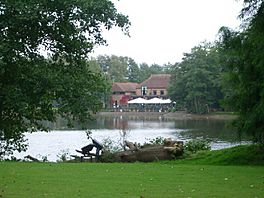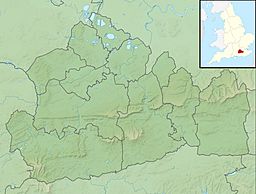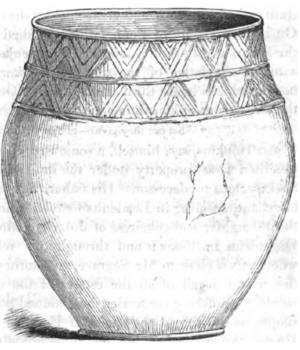Silvermere facts for kids
Quick facts for kids Silvermere |
|
|---|---|

Silvermere, looking east
|
|
| Location | Surrey |
| Coordinates | 51°20′09″N 0°27′03″W / 51.33583°N 0.45083°W |
| Type | Mere |
| Basin countries | United Kingdom |
| Surface area | 10 acres (4.0 ha) |
Silvermere is a special place in Surrey, England. It's named after its lake, which is called a 'mere'. This lake is about 10 acres big and often looks shiny and silver from the hills around it.
It was made in the 1800s for a wealthy architect named William Atkinson. Later, it became the home of the Seth Smith family, who were also rich from building homes and businesses. People found an ancient British burial mound here, and inside it, they discovered a special pot called the Silvermere Urn.
During World War II, the lake was used for secret tests of the famous 'bouncing bomb'. Today, Silvermere is a golf course. The very last hole of the golf course is on a small island in the lake!
Who Lived at Silvermere?
The Atkinson Family Home
Silvermere was once part of the Oatlands Palace estate. In 1830, an architect named William Atkinson bought 170 acres of land, which included the lake. He then built a house there.
Atkinson lived at Silvermere for ten years until he passed away. His son, Henry, then took over the estate.
A Garden Full of Rare Plants
Most of the land was wild heath before Atkinson bought it. But he loved horticulture, which is the art of growing plants. He planted many different kinds of rare plants and trees.
He had one of the best collections of pine trees in all of England. The farmhouse on the estate was made of peat turf. Even the dairy building had a turf roof, which helped keep it cool inside.
The Silvermere Urn: An Ancient Discovery
When Atkinson's house was being built, workers dug up a lot of earth. They found that they were digging into a burial mound. Inside, they discovered three special pots called burial urns.
These urns contained bones and charcoal. They were made of light clay and were about 18 inches tall. Experts believe they belonged to ancient British people. They were likely from a similar time period as the Iron Age settlement found nearby on St George's Hill.
The Seth-Smith Family
Charles Edward Seth-Smith (1822-1900) was the first of his family to own and live at Silvermere. He was the oldest son of Seth Smith, a very successful property developer.
His father built many parts of London, including areas in Belgravia and Mayfair, in the 1830s. He is also famous for the pantechnicon, a large building that gave its name to moving vans. The Silvermere estate was passed down through different members of the Seth-Smith family over the years.
Secret Bomb Tests at Silvermere
The Bouncing Bomb Idea
During the Second World War, the Seth-Smith family still owned Silvermere. Staff from the Vickers company, who were working on secret projects, were moved to this area. Facilities for developing the bouncing bomb were set up nearby in Foxwarren Park.
In 1942, Barnes Wallis, who invented the bouncing bomb, and his secretary, Amy Gentry, used the lake for experiments. They would row out onto the lake, and Wallis would launch different-shaped models from a catapult. Amy would then row to pick them up.
Demonstrating the Bomb
Later, in 1943, George Edwards, who managed the experimental department, used the lake. He showed how the bombs would spin and be released from the planes.
Lady Seth Smith, who owned the estate, was told the project was top secret. She was very happy to help, saying, "Anything to do with beating the Germans, me boy, you can have, but don't make much noise while you are doing it."
Silvermere Today: A Golf Course
Today, the Silvermere estate is a golf club with other fun activities. The golf course first opened in 1976. It is a "par 71" course, which means it's quite challenging.
The 17th and 18th holes require players to hit their golf balls across the lake. The green for the 18th hole, where players aim to finish, is on a small island in the middle of the mere!




